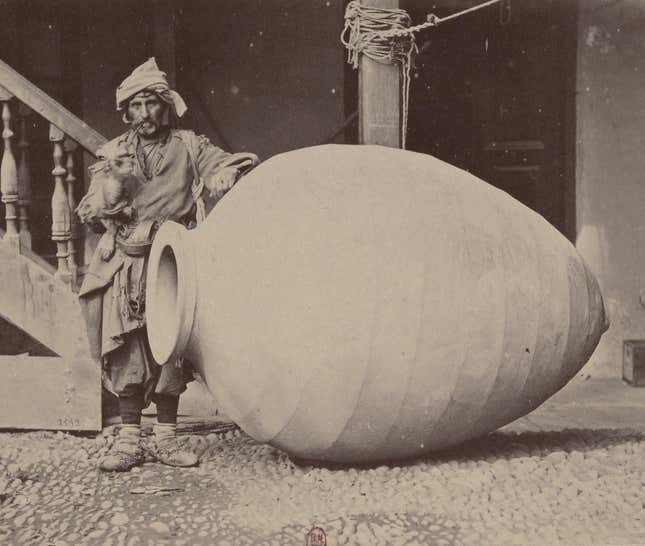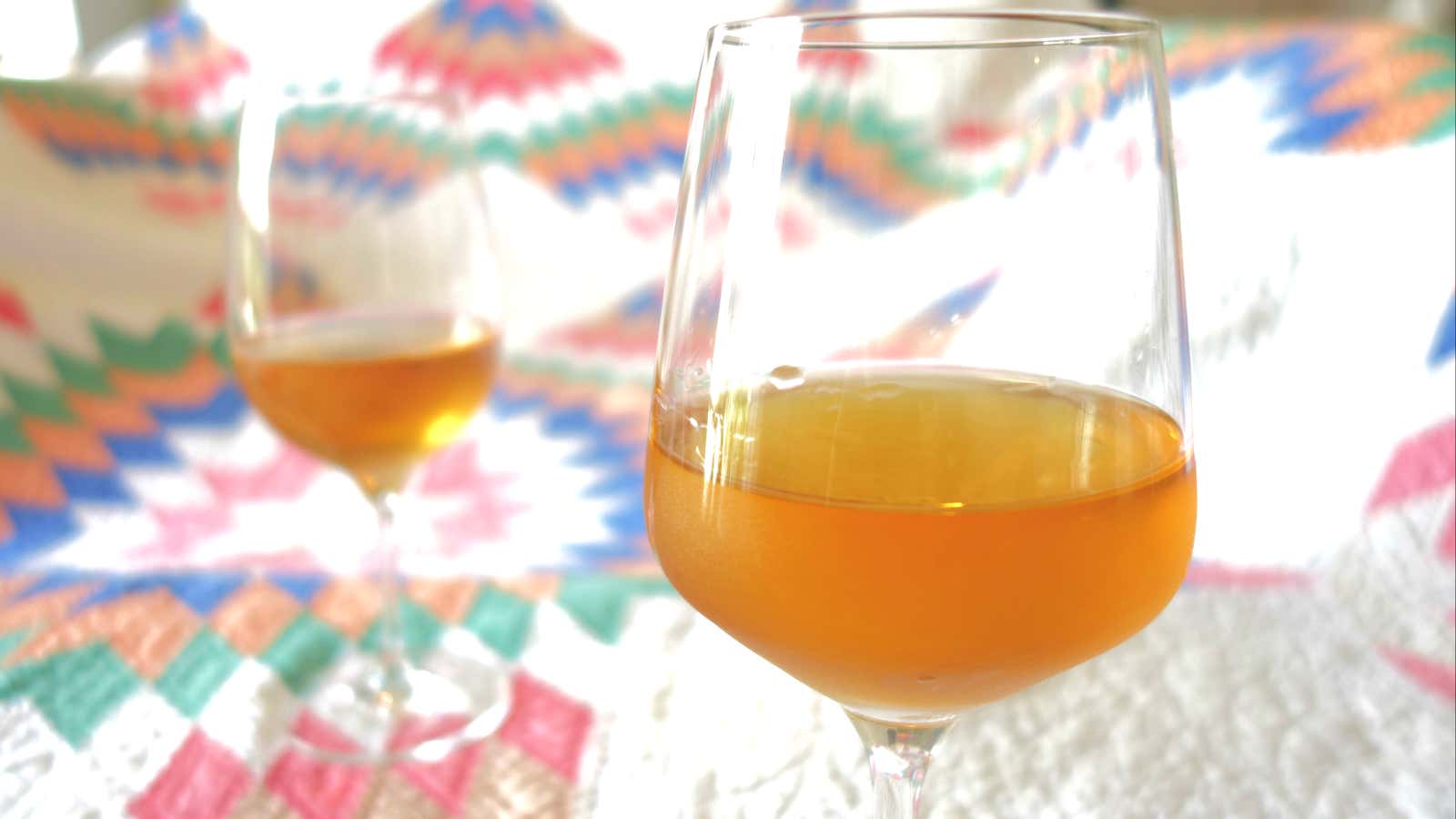On a recent night at Four Horsemen, a buzzy new wine bar in Williamsburg, Brooklyn, nearly everyone sipped wine of a similar shade. It wasn’t burgundy, ruby, yellow, or pink, but a peachy amber glow that filled their glasses, which shimmered with humidity on an August night.
The patrons, and I with them, were drinking “orange” wines. These wines, which can range from the palest melon whisper to deep, cloudy copper, are not made from oranges, but from grapes typically used for white wines. Unlike white wines, which are made from grapes fermented without their skins, skins are kept during orange wines’ production process. For this reason, they’re also called “skin contact” or “contact” wines.
The one in my glass, from the mountains of eastern Georgia (the country, not the state) smelled like apricots and nectarines. It felt full as a red but refreshing as a white, and stood up to—but didn’t destroy—the flavors of a rich country terrine with pickled green tomatoes and pert summer peas, strewn with Calabrian chilis, cashews, and ricotta salata. It knocked me out. Apparently, I’m not alone.
“I’m just completely shocked.”
Orange wines may still be under the radar for many casual wine drinkers, but they’re increasingly sought out by adventurous imbibers in search of something new.
“It’s really been crazy,” Justin Chearno, Four Horsemen’s wine consultant, said of the fervor for orange wines since the restaurant’s June opening. “We’re certainly not like, an ‘orange wine bar,’ but it is amazing when you come in, to see how many people have chosen that wine to drink.”
Chearno said he initially went easy on orange wines when designing the restaurant’s list, which favors natural wines made with little human intervention, but has since added around 30 orange wines, including bottles from Sicily, Slovenia, Austria, and Croatia.
“I would say that we’re [selling] about one-to-one, rosé to orange wine,” he said. “I’m just completely shocked.”
Perhaps he shouldn’t be. It was an orange wine, after all, that Chearno shared with the bar’s co-owner, James Murphy (the frontman of the retired, widely beloved rock band LCD Soundsystem) in 2008.
That Sicilian orange wine, Frank Cornelissen MunJebel Bianco No. 3, turned Murphy into a wine-lover, he told the New York Times, and later, a wine bar owner: “It was absolutely mind-blowing,” he said. “In my memory, there were leaves and twigs floating in it.”
The anti-rosé
Rather than the “new rosé,” consider orange wines an anti-rosé, with something of an inverse production process: While rosés are made from red grapes, with their skins removed early in the maceration time, orange wines are made from white grapes, which can stay with their skins—and even stems—for months, giving these wines a tannic structure that rosés generally lack.
“Rosé for me is basically just white wine with a little bit of color to it,” said Sebastian Zutant, the sommelier of the Red Hen restaurant in Washington D.C., and also the maker of Dahlia, a rosé.
“Don’t get me wrong, I love rosé,” he added. But, he said, “I can’t really understand $200 or $100 rosé. It doesn’t make any sense to me, whereas I can understand an expensive orange wine. They’re complex wines.”
That complexity makes orange wines great for adventurous eaters (and presumably, sommeliers), because they pair well across a wide variety of dishes—even tricky ones. “Octopus is always a bit of a conundrum,” Zutant said. “But the acidity of orange wines play well with the meaty-but-fresh flavor.”
Today’s orange wines can be Chardonnays, Muscats, Rieslings, and Sauvignon Blancs from Slovenia, Sicily, Friuli, or Long Island— and then some — but Zutant says for neophytes, he usually recommends a Rkatsiteli, a lesser-known varietal from Kakheti, Georgia, not unlike the one I loved at Four Horsemen.
“That’s really the jump-off of orange wines, for me,” he said. (And happily for drinkers, they’re not a $200 bottle.)

What’s old is new
Chearno agrees that when it comes to embracing orange wines, Georgia is the place to start—because that’s where it all started. The ancient Rkatstiteli (pronounced “er-kat-si-teli”) grape, one often used for contact wines, is still commonly planted in Georgia, a region many regard as the cradle of winemaking. (It was a “hotbed” in the Neolithic.)
“A grape that’s very perfumed, that’s very flowery in its aroma, drinking it without skin maceration, it feels a little bit two-dimensional and predictable,” says John Wurdeman, the founder of Pheasant’s Tears winery in the village of Tibaani in Kakheti, Georgia. “You give skin maceration, and turn it into an orange wine, and all of a sudden it goes from being something very pretty to being something very deep and compelling.”
Wurdeman makes his Rkatsiteli the same way it’s been done in the region for thousands of years.

The Kakheti region’s hot, dry, climate and desert-like temperature differentials ripens the grapes on the vine. Then they’re picked, gently crushed with their skins and stems, and buried in a qvevri —a clay vessel that preceded today’s oak barrels and stainless steel tanks—and left, sometimes for a few months.
The resulting wine, a long-legged, pale amber mouthful of tannic fruit with a touch of funk, is unlike any I’ve tasted. But oenophiles have known about them for years.
“The orange wines from Georgia are seen as very avant-garde, and a lot of hipster restaurants are taking them on,” said Wurdeman, adding that Japan is his fastest growing market for the wines.
“Actually,” he said. “It’s the most traditional way a wine could be made.”
